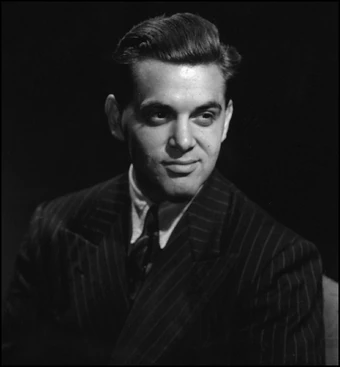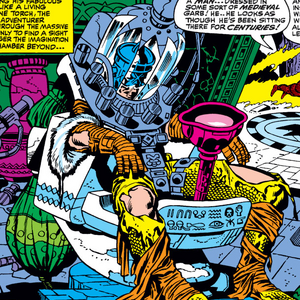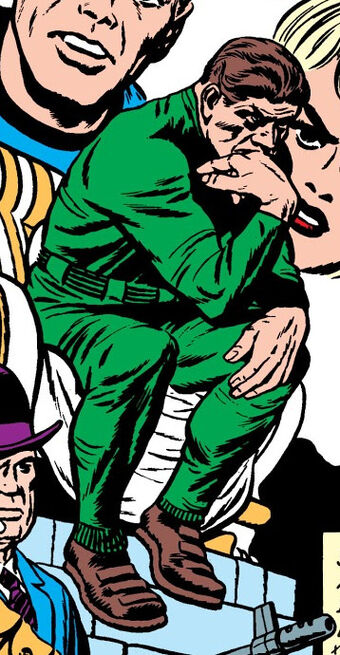 |
| via Spider-Man Wiki |
Jack Kirby was born Jacob Kurtzburg in New York City, August 28, 1917. He started working in comics in the 1930s and, over the course of his career, spent meaningful creative time with both Marvel and DC. He will always be best remembered for his work during Marvel's Silver Age, claiming co-creator status for Captain America, Fantastic Four, Thor, Avengers, Hulk, Iron Man, Black Panther, X-Men and Silver Surfer among many, many others. Make no mistake he, more than Stan Lee, was the creative force behind the pop cultural powerhouse that would eventually spawn the Marvel Cinematic Universe. He generated the look, fleshed out the characters and developed the worlds they roam. As discussed previously (read here), he played a much larger storytelling role than cover credits would have one believe. If only he'd lived long enough to make cameos in the movies...
Kirby was also drafted into the Army during World War II, landing on Omaha Beach two months after D-Day. When his commanding officer learned of Kirby's artistic talents, he assigned him as an advance scout to draw reconnaissance maps and pictures. During his tour, he suffered frostbite and nearly had his legs amputated. For his service, he received the Combat Infantry Badge, a European/African/Middle Eastern Campaign Medal and a Bronze Star.
Jack Kirby died of heart failure in 1994.
A few thoughts about the FF, too, before the week's issue notes: while character development was the initial hook for this series, I feel that long term, world-building was the greater strength. In this #31-60 stretch I've explored, the FF visited the Skrull world, the Inhumans' sanctuary and Wakanda, all for the first time. All three have provided rich narrative possibilities for Marvel in the decades since. In #48, the Silver Surfer was introduced and he has proven a more interesting character than any of the Fantastic Four themselves. His first solo series is where I'll be heading next.
My Recent Reads
Fantastic Four #54
Originally Published September 1, 1966
Writer: Stan Lee
Author: Jack Kirby
- There is no true villain in this issue. That's noteworthy in itself.
- The story opens with a baseball game in Wakanda. The FF, particularly Reed Richards, can't resist using their powers - poor sportsmanship.
- The Black Panther enlists a world-famous pianist to play Grieg's Piano Concerto for his guests. It's one of my favorite pieces. Read here.
- Another interesting change from what I've seen with the series up to this point: the beginning of two split, multi-issue threads: one for Johnny Storm and Wyatt Wingfoot as Johnny seeks a way to get back to Crystal of the Inhumans and another for the others returning to New York.
 |
| via Marvel Database |
- Johnny and Wyatt meet Prester John, also known as The Wanderer.
Fantastic Four #55
October 1, 1966
Lee/Kirby
- The Silver Surfer returns. Thing picks a fight with him, jealous over Alicia's apparent interest in him. Thing fails to understand that her feelings for the Silver Surfer are not romantic in nature.
- Finally reaching the Himalayas (I could have sworn the Inhumans were in the Andes but I guess not), Johnny and Wyatt encounter Lockjaw, the Inhumans' faithful, dimension-jumping hound.
Fantastic Four #56
November 1, 1966
Lee/Kirby
- Villain: Klaw, attacking the three FF members in New York in an effort to draw out the Black Panther.
- Johnny and Wyatt follow Lockjaw through several dimensional jumps. Wyatt is trying to train the dog to lead them to the Inhumans, something he's clearly been trained previously not to do.
Fantastic Four Annual #4
November 1, 1966
Lee/Kirby
- The Fantastic Four are reunited.
- Villain: The Thinker
 |
| via Marvel Database |
- The Thinker has enlisted the help of the original Human Torch, an android character who first appeared in October 1939.
 |
| via Wikipedia |
Fantastic Four #57
December 1, 1966
Lee/Kirby
- Main villains: Sandman and Wizard
- Meanwhile, a separate thread begins in which the Silver Surfer visits Dr. Doom. The latter steals the powers of the former.
- Mary Poppins reference!
Fantastic Four #58
January 1, 1967
Lee/Kirby
- Villain: Dr. Doom, enhanced by the powers he stole from the Silver Surfer
- The issue ends with a cliffhanger, the FF having suffered apparent defeat.
I'd forgotten the original Torch returned to the MU so early on.
ReplyDeleteI have my own thoughts on the Kirby/Lee thing, but...
Well, it echoes my thoughts about McFarlane in the 90s.
I'm a writer, and I'm biased, I suppose.
I am not arguing that the art is less important than the writing. I'm suggesting that at this stage of their working relationship, Jack was doing a lot more of the writing, in effect, than Stan was contributing to the art. It's impossible to know for certain, of course. Just as it's impossible to know for certain if Paul's telling the truth when he says certain Lennon-McCartney tunes were all his work. There are two people who would know for certain and one of them's been dead for 40 years.
DeleteThis much I can assert with total confidence: Kirby has not gotten enough of the credit over the years. Stan Lee deserves plenty, don't get me wrong. But he also benefited from living longer and, quite frankly, possessing better self-promotion skills.
It is what it is. Jack deserves some love. His artwork is amazing.
He does deserve some love. I wasn't trying to say he doesn't.
DeleteThe problem with why he went unrecognized for so long was mostly him.
He gets no love for his work at DC.
Always been a big fan of Kirby's artwork.
ReplyDeleteTruly amazing, especially considering the limitations in color printing at the time. Some of his full-page panels are genuinely beautiful.
DeleteGreat read but quite confusing for me.
ReplyDeleteparsnip
Sorry to confuse. I will admit, this series of mine is a bit clunky - even a tad self-indulgent? I can imagine they're more fun for me to write than for anyone else to read, unless they really care about comic books.
Delete